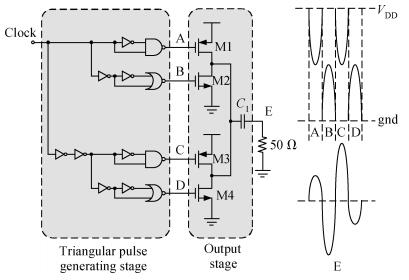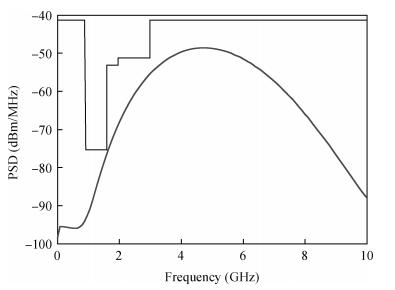| Citation: |
Jin He, Jiang Luo, Hao Wang, Sheng Chang, Qijun Huang, Yueping Zhang. A CMOS fifth-derivative Gaussian pulse generator for UWB applications[J]. Journal of Semiconductors, 2014, 35(9): 095005. doi: 10.1088/1674-4926/35/9/095005
****
J He, J Luo, H Wang, S Chang, Q J Huang, Y P Zhang. A CMOS fifth-derivative Gaussian pulse generator for UWB applications[J]. J. Semicond., 2014, 35(9): 095005. doi: 10.1088/1674-4926/35/9/095005.
|
A CMOS fifth-derivative Gaussian pulse generator for UWB applications
DOI: 10.1088/1674-4926/35/9/095005
More Information
-
Abstract
A CMOS fifth-derivative Gaussian pulse generator is presented for ultra-wideband (UWB) applications. The design exhibits low power consumption, low circuit complexity, and a precise pulse shape to inherently comply with the FCC spectrum mask for indoor UWB applications without the need for a filter. The pulse generator is implemented with a 1.8-V, 0.18-μm CMOS process. The small core chip size of the pulse generator is only 217×121 μm2 because of its all digital circuit design. The measured fifth-derivative Gaussian pulse has a peak-to-peak amplitude of 158 mV and a pulse width of 800 ps. The average power dissipation is 0.6 mW with a pulse repetition frequency of 50 MHz.-
Keywords:
- CMOS,
- pulse generator,
- ultra-wideband (UWB),
- impulse radio (IR)
-
References
[1] FCC. Revision of part 15 of the commission's rules regarding ultra-wideband transmission system. FCC First Report and Order, Feb. 14, 2002 http://ci.nii.ac.jp/naid/10011635725[2] Jeong Y, Jung S, Liu J. A CMOS impulse generator for UWB wireless communication systems. IEEE Int Circuits Syst Symp, 2004:129 https://utdallas.influuent.utsystem.edu/en/publications/a-cmos-impulse-generator-for-uwb-wireless-communication-systems[3] Zheng Y, Zhang Y P, Tong Y. A novel wireless interconnect technology using impulse radio for interchip communications. IEEE Trans Microw Theory Tech, 2006, 54(4):1912 doi: 10.1109/TMTT.2006.872070[4] Norimatsu T, Fujiwara R, Kokubo M, et al. A UWB-IR transmitter with digitally controlled pulse generator. IEEE J Solid-State Circuits, 2007, 42(6):1300 doi: 10.1109/JSSC.2007.897137[5] Ryckaert J, Desset C, Fort A, et al. Ultra-wide-band transmitter for low-power wireless body area networks:design and evaluation. IEEE Trans Circuits Syst I, Reg Papers, 2005, 52(12):2515 doi: 10.1109/TCSI.2005.858187[6] Phan A T, Lee J, Krizhanovskii V, et al. Energy-efficient low-complexity CMOS pulse generator for multiband UWB impulse radio. IEEE Trans Circuits Syst I, Reg Papers, 2008, 55(11):3552 doi: 10.1109/TCSI.2008.925821[7] Sheng H, Orlik P, Haimovich A M, et al. On the spectral and power requirements for ultra-wideband transmission. IEEE Int Conf Commun, 2003:738 http://citeseerx.ist.psu.edu/viewdoc/summary?doi=10.1.1.332.3837[8] Kim H, Joo Y. Fifth-derivative Gaussian pulse generator for UWB system. IEEE RFIC Symp Dig Papers, 2005:671 http://ieeexplore.ieee.org/articleDetails.jsp?arnumber=1489903[9] Kim H, Park D, Joo Y. All-digital low-power CMOS pulse generator of UWB system. IEE Electron Lett, 2004, 40(24):1534 doi: 10.1049/el:20046923[10] Xie H L, Wang X, Wang A, et al. A varying pulse width fifth-derivative Gaussian pulse generator for UWB transceivers in CMOS. IEEE Radio Wireless Symp, 2008:171 http://ieeexplore.ieee.org/stamp/stamp.jsp?tp=&arnumber=4463456&isnumber=4463396 -
Proportional views






 DownLoad:
DownLoad:























